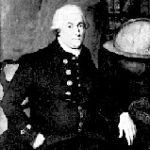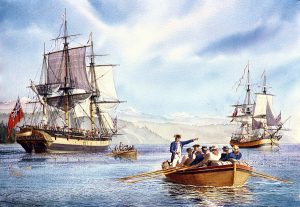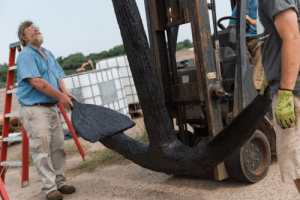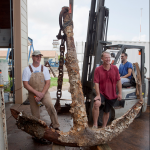
 In the years between 1791 and 1794, a man named Captain George Vancouver was exploring the Pacific Northwest area which would eventually become part of the United States of America. Captain Vancouver was the commander of the HMS Discovery and its accompanying ships sent to survey the northern Pacific Ocean. It was Vancouver and his crew who first recorded the sighting of Mount Saint Helens, and the first to explore Puget Sound. Following the coasts of Oregon and Washington and intending to explore every bay and outlet of the region, he sent men in smaller boats to explore the Columbia River and enter the strait of Juan de Fuca.
In the years between 1791 and 1794, a man named Captain George Vancouver was exploring the Pacific Northwest area which would eventually become part of the United States of America. Captain Vancouver was the commander of the HMS Discovery and its accompanying ships sent to survey the northern Pacific Ocean. It was Vancouver and his crew who first recorded the sighting of Mount Saint Helens, and the first to explore Puget Sound. Following the coasts of Oregon and Washington and intending to explore every bay and outlet of the region, he sent men in smaller boats to explore the Columbia River and enter the strait of Juan de Fuca.
Vancouver commanded a variety of ships to complete his mission, so while the smaller vessels explored the many channels and rivers along the coast, the larger ships, including the Armed Tender of the HMS Discovery, called the Chatham, often anchored in safe harbors. On April 29, 1792, the ships entered the Straits of Juan de Fuca and anchored in the calm waters of Discovery Bay. Utilizing the bay as a base, Vancouver and his men explored the waters of Admiralty Inlet and Hood Canal.
Several weeks later, the Chetham began to sail north across the Straits of Juan de Fuca to explore the San Juan and Lopez Islands. After successfully doing so, the Chatham sailed southward in May to rejoin the HMS Discovery and continue their explorations south. The explorations continued as far as Commencement Bay in Tacoma, before turning around and returning north, where the waters were safer. Arriving at Puget Sound, they found a storm raging with severe currents and tides. Crossing an unknown channel, the Chatham was caught by a flood tide and swept helpless. To slow her progress, her stream anchor was dropped but the strain was too much and the cable snapped. However, the Chatham survived and after sweeping the waters unsuccessfully for the anchor, the ship rejoined the HMS Discovery.
Vancouver would write in his journal on June 9, 1792: “We found tides here extremely rapid, and on the 9th in endeavoring to get around a point to the Bellingham Bay we were swept leeward of it with great impetuosity. We let go the anchor in 20 fathoms but in bringing it up such was the force of the tide that we parted the cable. At slack water we swept for the anchor but could not get it. After several fruitless attempts, we were at last obliged to leave it.”
In 2008, an anchor was located off Whidbey Island’s northwestern shore. The anchor they found is believed to be the lost Chatham anchor, that was thought to be in Bellingham Bay. Anchor Ventures, LLC of Seattle salvaged the anchor, thought to be the one documented in mariners’ journals as breaking free from the 
 Chatham in heavy currents on June 9, 1792. Previous searches for the anchor had been focused in Bellingham Channel, where the main ship Discovery had been with high seas reported. The Chatham, a brig that was eventually captained by Peter Puget, was apparently not with the Discovery during the storm, the salvage team believes. The anchor was placed temporarily at the Northwest Maritime Center in downtown Port Townsend before being moved to Texas, where is was restored and is on display today.
Chatham in heavy currents on June 9, 1792. Previous searches for the anchor had been focused in Bellingham Channel, where the main ship Discovery had been with high seas reported. The Chatham, a brig that was eventually captained by Peter Puget, was apparently not with the Discovery during the storm, the salvage team believes. The anchor was placed temporarily at the Northwest Maritime Center in downtown Port Townsend before being moved to Texas, where is was restored and is on display today.


Leave a Reply